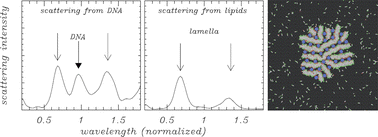Molecular simulation analysis of structural variations in lipoplexes
Abstract
We use a coarse-grained molecular model to study the self-assembly process of complexes of cationic and neutral

a Department of Biomedical Engineering, Ben Gurion University of the Negev, Be'er Sheva, Israel
b Ilse Katz Institute for Nanoscale Science and Technology, Ben Gurion University of the Negev, Be'er Sheva, Israel
c Department of Applied Science, University of California, Davis, California, USA
d The Niels Bohr International Academy, The Niels Bohr Institute, Blegdamsvej 17, Copenhagen, Denmark
We use a coarse-grained molecular model to study the self-assembly process of complexes of cationic and neutral

 Please wait while we load your content...
Something went wrong. Try again?
Please wait while we load your content...
Something went wrong. Try again?
O. Farago and N. Grønbech-Jensen, Soft Matter, 2011, 7, 4302 DOI: 10.1039/C0SM01498B
To request permission to reproduce material from this article, please go to the Copyright Clearance Center request page.
If you are an author contributing to an RSC publication, you do not need to request permission provided correct acknowledgement is given.
If you are the author of this article, you do not need to request permission to reproduce figures and diagrams provided correct acknowledgement is given. If you want to reproduce the whole article in a third-party publication (excluding your thesis/dissertation for which permission is not required) please go to the Copyright Clearance Center request page.
Read more about how to correctly acknowledge RSC content.
 Fetching data from CrossRef.
Fetching data from CrossRef.
This may take some time to load.
Loading related content
